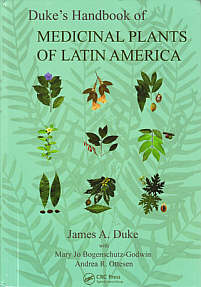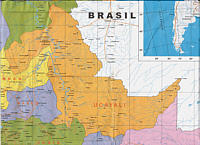|
Vermicidal / Anti-Tumor / Analgesic


 Summarized Description: Summarized Description:
The product is an herbal blend of Paico and Peppermint -- both possessing
vermicidal properties, with the former the stronger contributor to this
medicinal property. Despite the efforts of the medical establishment
to "pooh-pooh" Paico's worm-killing capabilities, studies have consistency
bore out its efficacy. In one
study conducted in Peru
[ Span.]
Paico demonstrated a 100% success rate
in killing Ancylostoma
and Trichuris (roundworm)
and a 50% kill rate for Ascaris.
Other studies describe the process by which intestinal worms are
paralyzed by Paico and eliminated
from the digestive tract. Despite having a wide array of other properties (see below),
Paico's use as an vermicidal agent is still
its most common medicinal use.

Uses & Protocols
 Preparation is easy : this is a
standard decoction. Take 20 grams (approximately 1/4 of the contents of the
bag or roughly 5 Tablespoons) and add to one gallon of purified water. (You may
prorate from this.) Bring to a boil
and then let sit at simmer for 15 minutes. Drink one 8 oz. glass three to four
times a day ("Plantas Medicinales de Uso Popular en la Amazonia Peruviana").
For minor parasitic issues, Peruvians follow this regimen for four days;
more serious parasites, seven days.
Leslie Taylor recommends a lower dose of 1/2 cup
once daily as a maintenance dose. The three day duration appears to be
widely recommended.
 Directions for Capsule Use: Directions for Capsule Use: Take two capsules, two times a day, or as otherwise
directed by your practitioner.
Warnings & Contraindications
 If you are going to use Paico internally as a
vermifuge, use a tea product like the one that we sell. There is a small
quantitative difference between the therapeutic dosage of the seed oil of this plant
and its legal dosage. Drinking a tea made from the leaves, as we suggest, is the safest way
to take it. It is also the way in which indigenous peoples traditionally ingest it,
as well. If you take Paico as we prescribe, you will avoid overdosing,
the symptoms of which include headache, dizziness, vomiting and convulsions.
 Paico is an abortifacient. Never take this
product during pregnancy, while trying to conceive, or while lactating (breast-feeding).
Shelf-Life
 Five years or more.

Medicinal Activities
 Further information for practitioners: Further information for practitioners:
World-famous botanist Dr. James Duke attributes the following activities
to this plant (p. 277-283; see hardcopy cover at right),
drawn from the extant literature. (See his graduation for "level of
efficacy" on our amazon traditionals page;
followed by Duke's bibliographic abbreviations (in capital letters),
which we identify
on a separate page.)
- Abortifacient (f; CRC, PH2, WBB; ZUL);
- Acaricide (1; MD2, X15384350);
- Amoebicide (1; CRC; MPG);
- Analgesic (f1; CRC; TRA);
- Antemetic (f; EGG);
- Anthelmintic (f1; BOU; PHR; PNC; TRA; 60P);
- Antiaflatoxigenic (1; X17174000);
- Antiasthmatic (f; PH2);
- Anticancer (1; X16307762);
- Antifeedant (f; ZUL);
- Antiinflammatory (f; VOD);
- Antileishmanic (f1; X16636536; X17254746; X8701041);
- Antimalarial (1; TRA);
- Antioxidant (1; X16307762; X17174000);
- Antiseptic (f1; AHL; EGG; ZUL; 60P);
- Antispasmodic (f; BOU; CRC; DEP; JTR; WBB; WO2; ZUL; 60P);
- Antitumor (1; X16307762);
- Antitussive (f; CRC; EGG);
- Anti-ulcer (1; MPG; TRA; 60P);
- Apifuge (1; ZUL);
- Ascaricide (1; AAB; CRC);
- Bactericide (1; TRA);
- Carcinogenic (1; AAB; TRA);
- Cardiodepressant (1; MPG; TRA);
- Cardiotone (f; ZUL);
- Carminative (f1; BOU; CRC; DAV; FAD);
- Contraceptive (f; DAV; EGG; SAR);
- Cytotoxic (1; X16219440);
- Decongestant (f; DAV);
- Depurative (f; DAV);
- Diaphoretic (f; CRC; WBB; ZUL);
- Digestive (f; BOU; VOD);
- Diuretic (f; CRC);
- Emmenogogue (f; BOU; CRC; DEM; JFM);
- Febrifuge (f; BOU; DEM);
- Fungicide (f1; AAB, TRA; X17174000; 60P);
- Genotoxic (1; X16219440);
- Hepatoprotective (f; EGG);
- Hypotensive (1; TRA; 60P);
- Insecticide (1; CRC; TRA; X15384351);
- Lactagogue (f; BOU; CRC);
- Myorelaxant (1; MPG; TRA; 60P);
- Narcotic (f; CRC);
- Nematocide (f1; GMJ; JE92:215; X17588325);
- Nervine (f; CRC);
- NO-genic (1; X17156956);
- Panacea (f; DEM);
- Paralytic (1; PHR);
- Parasiticide (f; VOD);
- Pectoral (f; WO2);
- Plasmodicide (f; WO3);
- Poison (1; CRC; JFM)
- Protisticide (1; TRA);
- Purgative (f; DAV);
- Respirostimulant (1; MPG; TRA);
- Sedative (f; AAB);
- Snake Repellent (f; ZIM, ZUL);
- Spasmogenic (1; PHR);
- Stimulant (f; BOU; CRC; PH2);
- Stomachic (1; BOU, CRC; HHB);
- Sudorific (f; CRC);
- Tonic (f; CRC; DEM; DEP; HHB);
- Tumorigenic (1; X625070);
- Vermifuge (f12; FAD; PHR; VOD; ZUL).
Indications
 Further information for practitioners: Further information for practitioners:
Duke provides the following indications for this plant:
- Abscesses (f; EGG; RAR);
- Amoebiasis (12; CRC; FAD; IED; KAP);
- Amenorrhea (f; CRC);
- Anemia (f; CRC; WO2; ZUL);
- Angina (f; MPB);
- Apoplexy (f; DLZ);
- Appendicitis (f; CRC; JFM);
- Arthrosis (f; CRC; DAV; EGG);
- Asthma (f; IED; MPG; PH2; 60P);
- Athlete's Foot (f; EGG);
- Bacillus (1; WO2);
- Bacteria (1; JE66:347);
- Bites (f; CRC; JFM; MPG);
- Bleeding (f; PH2);
- Brochosis (f; VOD);
- Bruises (f; EGG; JFM);
- Burns (f; JFM);
- Cancer (f1; JLH; X16307762; X17707603);
- Cancer, eye (f; JLH);
- Cancer, uterus (f; JLH);
- Caries (f; RAR);
- Chest Ache (f; DEM; ZIM);
- Childbirth (f; CRC; JFM);
- Cholera (f; DAV);
- Chorea (f; JFM);
- Colds (f; ZUL);
- Colic (f; CRC; JTR; MD2, MPG; ZUL);
- Conjunctivosis (f; AHL; VOD);
- Convulsions (f; VAG; ZIM; ZUL);
- Coughs (f; EGG; MPG; WO2; ZUL);
- Cramps (f; BOU; DAV; PH2; ZUL);
- Delirium (f; ZIM);
- Dermatophyte (f; CRC);
- Dermatosis (f; CRC; DAV; MPG; 60P);
- Diarrhea (f; TRA);
- Dislocation (f; JFM);
- Dysentery (f; CRC; KAP);
- Dyslactea (f; BOU);
- Dysmenorrhea (f; CRC; MPG);
- Dyspepsia (f1; CRC; DAV; JFM);
- Dyspnea (f; CRC; JFM);
- Dysuria (f; JFM);
- Eczema (f; PH2; ZUL);
- Enterosis (f; CRC, EGG; MKK; WO2);
- Epilepsy (f; DLZ);
- Erysipelas (f; HHB; ZUL);
- Fatigue (f; CRC);
- Fever (f; BOU; VAG; ZIM; ZUL);
- Flu (f; DAV);
- Fracture (f; EGG; JFM);
- Fungus (f1; CRC; EGG; X17174000);
- Gas (f1; FAD; FNF; JFM);
- Gastralgia (f1; TRA);
- Gastrosis (f; DEM; EGG; NPM; TRA);
- Gonorrhea (f; DEM);
- Gout (f; DAV);
- Guinea Worm (1; WO2);
- Hangover (f; AAB);
- Headache (f; DEM);
- Hemiplegia (f; DLZ);
- Hemorrhoids (f; DAV; EGG; MPG; JTR; 60P);
- Hepatosis (f; DLZ; TRA);
- High Blood Pressure (1; MPG; 60P);
- Hookworm (f12; CRC; FAD; KAP);
- Hyperacidity (f; EGG);
- Hysteria (f; DAV; WO2);
- Induration (f; JLH);
- Infection (1; JE66:347; ZUL; 60P);
- Inflammation (f; MPG; 60P);
- Insanity (f; VAG);
- Insomnia (f; AAB; ZUL);
- Jaundice (f; DLZ);
- Laryngitis (f; DAV);
- Laziness (f; DEM);
- Leishmania (f1; X16636536; X17254746; X8701041);
- Leprosy (f; ZUL);
- Madness (f; ZIM; ZUL);
- Malaria (f1; MPG; TRA; WO2; WO3; 60P);
- Measles (f; CRC; JFM; ZUL);
- Metrorrhagia (f; PH2);
- Mycosis (f1; CRC; EGG; TRA; X17174000; 60P);
- Nausea (f; EGG);
- Nematode (f1; JE92:215; X17588325);
- Nephrosis (f; 60P);
- Nervousness (f; DEM);
- Neurosis (f; CRC; MPG; ZUL);
- Ophthalmia (f; JLH);
- Pain (f1; CRC; JFM; TRA; VAG; ZUL);
- Palpitations (f; CRC; JFM);
- Paralysis (f; PH2);
- Parasites (f1; AAB; AHL; HHB; JFM; TRA; VOD);
- Plasmodium (1; WO3);
- Proctorrhagia (f; CRC; JFM);
- Pseudomonas (1; WO2);
- Peurperium (f; CRC);
- Pulmonosis (f; EGG);
- Rheumatism (f; CRC; DEM; EGG; PH2);
- Roundworm (f12; CRC; FAD; KAP; PHR);
- Smallpox (f; ZUL);
- Sores (f; CRC; TRA; WO2; X8701041);
- Spasms (f; JTR);
- Splenomegaly (f; ZUL);
- Staphylococcus (1; WO2);
- Stings (f; MPG);
- Stomachache (f; DAV; EGG; JTR; TRA; WO2; ZUL; 60P);
- Swelling (f; DEM; EGG);
- Tapeworm (2; FAD; PHR);
- Toothache (f; CRC; DEM; JFM);
- Trypanosomiasis (1; JNP65:509);
- Tuberculosis (f1; DAV; JE66:347);
- Tumors (f1; CRC; DAV; X16307762; X17156956);
- Ulcers (f1; MPG; NPM; TRA; WO2; ZUL; 60P);
- Urethrosis (f; EGG);
- Uteralgia (1; VAG; ZIM; ZUL);
- VD (f; DEM);
- Worms (f; BOU; CRC; DEM; MD2);
- Wounds (f; MD2).
|
 To U.S. Users: To U.S. Users: This product
have not been evaluated by the U.S. Food & Drug Administration.
It is not intended to diagnose, treat, cure, or prevent any disease.
|
 Sourcing From
Sourcing From
The Peruvian
Amazon
 All the materials used to
make our AO Paico Blend are wild-crafted from sources in
the Ucayali Region of Peru.
Dosages &
Ethnobotanical
Usage
 Duke
provides a "food farmacy potential" score for this plant of, "FNFF=?" ("Very questionable
survival food . . .)." Dosages: "Though often listed as an edible
potherb, as an anti-gas spice in soups and salsas, or used in preparation
of hot pepper sauces, etc., I'd use very sparingly! Topically applied in
hemorrhoids (SOU). 1 g (HHB); 2-4 ml. liquid extract (PNC); 0.03-0.1 g fresh shoots / kg / day,
no more than 3 days; not more often than once every 6 months (TRA);
1-4 g. powdered seed (PNC); 4 tsp. powdered seed at bedtime, for 4 days, as anthelmintic
(NPM) (much to much for safety (JAD)). Adult dosage: 20 drops in a.m. on empty stomach
followed by purgative in 2 hr (PH2); pediatric dose; 1 drop for each year of age,
repeat in 1 hr. (PH2). "
- Afro-Brazilian Candomblé: Take leaf juice or tea for hysteria
and internal pain (VOD).
- Belize: Boil root of 1 large plant 10 min. in 2 cups water
for hangover ("crudo"). Also, Paico taken as hot leaf tea, sedative (AAB).
- Cuba: Use as anthelmintic, antispasmodic, hemostat, stomachic, and vermifuge,
for colic and stomachache (JTR).
- Haiti: Rub the shoot onto the skin to kill parasites (VOD) or use shoot
infusion as a digestive and stomachic.
- Mexico: Infuse 20 g leaves in a 1 liter water as diuretic, emmenagogue, sudorific,
and vermifuge (JFM).
- New Mexican Latinas take leaves with salt as abortifacient or for postpartum pain (JFM).
- Nigerians: Paste leaves and seeds ijn palm oil on guinea worm (WO2).
- Peru: Madre de Dios Peruvians wash wounds with paico and tobacco tea (MD2);
elsewhere in Peru, leaves are topically applied topically to treat arthritis (EGG);
leaf tea is taken for acid stomach, diabetes, dysmenorrhea, gas, hemorrhoids,
and rheumatism (EGG); decoction used for colds, colic, gastrosis, urethrosis, and
worms (EGG; MD2).
- Tikuna: Take root / shoot decoction during menstral cycle each month as contraceptive (SAR).

 Above: Mentha piperita Above: Mentha piperita
growing wild. Below: Like Paico, this herb is frequently found
in the marketplace growing in small, discrete bundles.


|











